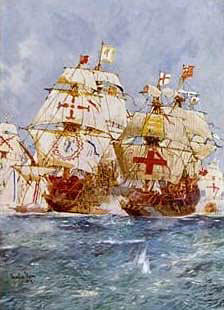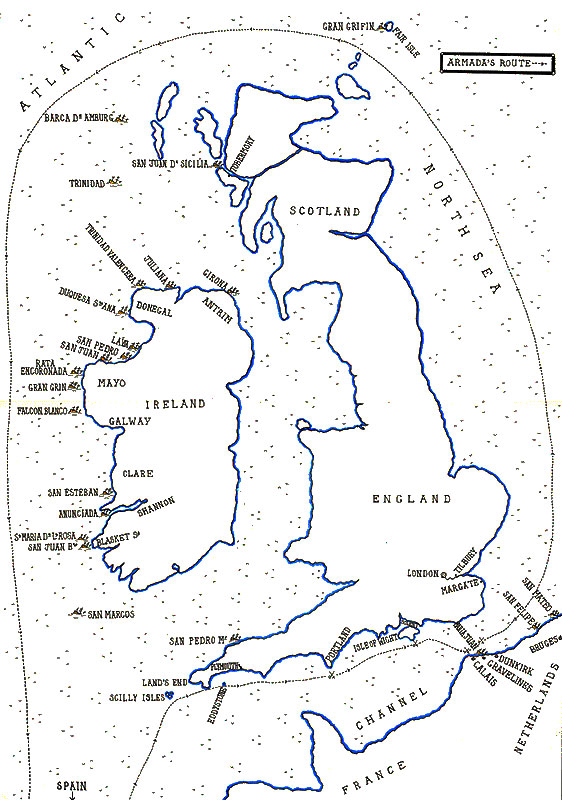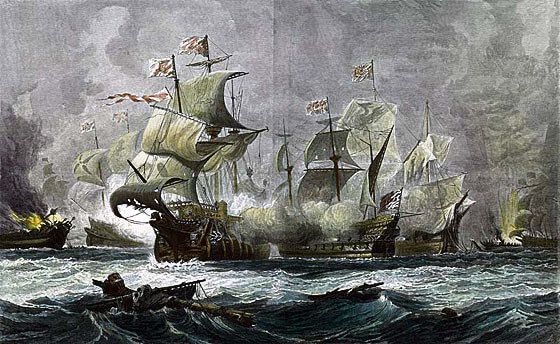The Spanish Armada
The spectacular but unsuccessful attempt by King Philip II of Spain to invade Elizabethan England in 1588. The Armada is for the English the classic foreign threat to their country and a powerful icon of national identity Date: June to September 1588.
Area of the Spanish Armada campaign: The English Channel, the North Sea and the seas around the North and West of Scotland, the Orkneys and the West of Ireland.
Combatants in the Spanish Armada campaign: The Armada (Spanish for “Fleet”), manned by Spaniards, Portuguese, Italians, Germans, Dutch, Flemings, Irish and English against the English Fleet assisted by the Dutch Fleet.
Commanders in the Spanish Armada campaign: Spanish commanders were the Duke of Medina Sidonia
and the Duke of Parma against the English commanders Lord Howard of Effingham, High Admiral of England, Sir John Hawkins, Sir Martin Frobisher, Sir Francis Drake, Lord Henry Seymour and Sir William Winter.
Armada, June to September 1588: Lord Howard in the Ark attacks San Martin, flagship of the Duke of Medina Sidonia. Both ships carry the red cross on the white background, the crusader symbol and the symbol of St George
Size of the navies in the Spanish Armada campaign: The Spanish Armada sailed with around 160 ships. The English mobilised up to 200 ships in the Channel. Unknown numbers of Dutch vessels harassed and attacked the Armada and hemmed the Duke of Parma’s forces into their harbour of Dunkirk.
Ships, organization, tactics and equipment: The descent of the Spanish Armada on England in 1588 ocurred at a time of profound change in sea warfare. The Spanish represented the old tradition while the English fought with a new design of warship and new tactics.
In medieval warfare at sea soldiers added castles to the merchant trading vessel at the front and the rear (fore castle and after castle) and at the top of the mast and fought their fleets as if on land, discharging arrows and handguns, boarding the enemy ships and conducting hand to hand fighting.
The ships incorporated by the Spanish in the Armada represented this tradition. The main Spanish vessels were galleons, sailing ships that rode high out of the water with towering fore and after castles from which handheld firearms were discharged; while the crews grappled the enemy ships so that soldiers could board and capture them. Their height and broad beam made these ships awkward to sail.
English captains, particularly John Hawkins and Francis Drake, inspired a new form of ship for the Queen’s Navy, the “race ship”, of which around 25 were built. Lower in the water, with a long prow and much reduced fore and after castles, these sleek ships carried more sophisticated forms of rigging, enabling them to sail closer to the wind, making them faster and more manoeuvrable than the Spanish ships.
England had no standing army, so her naval vessels were crewed by sailors alone. English fighting ships relied increasingly on gunnery rather than boarding to defeat an enemy.

Route of the Spanish Armada in 1588, up the Channel into the North Sea, North About into the Atlantic and down the west coast of Ireland. The map shows the known wrecks of Armada ships. Of the 120 ships in the Armada half were lost many just disappearing. The map shows the sites of the engagements between the Armada and the English Fleet at Eddystone, Portland, Isle of Wight, Calais and Gravelines. Of the Armada’s complement of 30,000 soldiers and sailors 20,000 were lost: map by John Fawkes
Initially the English attempted to disable the Armada ships with long range gunfire. This form of gunnery did little damage other than to rigging which was easily replaced. The lesson was learnt and at the Battle off Gravelines the English closed in and fired repeated broadsides into the Spanish ships at short range, inflicting considerable damage and sinking several ships.
The different Spanish tradition of sea fighting prevented the Armada from countering English gunfire. Guns in Spanish ships were fired in a single salvo as a prelude to boarding; one soldier remaining by each gun for this duty while the rest of the gun teams took their places among the boarders on deck. The Spanish crews were not trained to load and fire repeatedly during a battle and the carriages and tackles of the guns were not designed or suitable for this function; the system of wheels and tackle restricting recoil rather than easing it.

Battle of Gravelines on 28th July 1588: Vanguard engages two Spanish galleons: Spanish Armada June to September 1588
Throughout the Armada’s journey up the Channel and at the Battles of Portland and Gravelines the Spanish struggled unavailingly to bring the nimble English ships within grappling and boarding distance; while suffering constant bombardment that killed many men, sank some ships and damaged others to such an extent that they foundered on the voyage home.
After Gravelines it was found that no English ships had suffered hull damage, while many of the Spanish ships were severely damaged by canon fire, much of it below the waterline. Examination of Spanish canon balls recovered from wrecks showed the Armada’s ammunition to be badly cast, the iron lacking the correct composition and too brittle, causing the balls to disintegrate on impact, rather than penetrating the hull. Several guns were found to have been badly cast and of inadequate composition, increasing the danger of bursting and killing or injuring the gun crews.



History
ReplyDeleteHistory
Date Of Birth:- 30 January 1974
Popular Name: Jemima Khan (Jemima Imran Khan Niazi)
She is a British playwright, Documentary and television, film producer, and the founder of Instinct Productions, a television production company. She is a dramatist and television, film, and documentary producer from the United Kingdom, as well as the founder of the television production firm Instinct Productions.